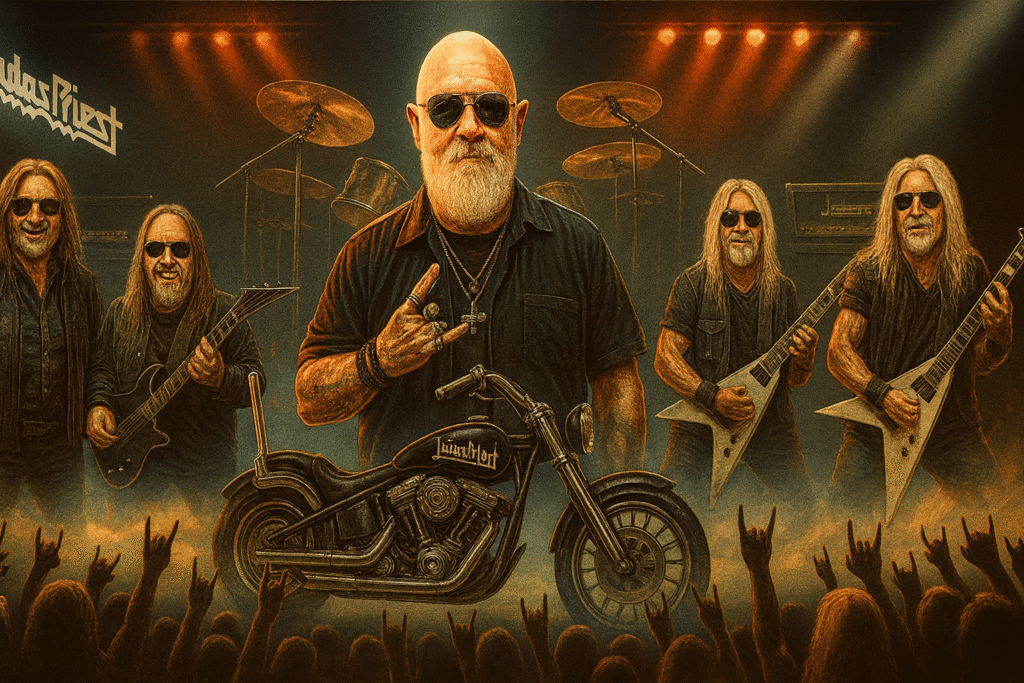
AI-generated image for illustrative purposes.
You can love ’em or hate ’em, but the fact is Judas Priest didn’t invent heavy metal — they sharpened it, hardened it, and handed it to the world fully forged. If Black Sabbath was the dark prophet and Deep Purple the alchemist, then Judas Priest was the architect: they gave the genre its form, style, and sound. Without leather, studs, twin guitars, and those supernatural screams, modern metal simply wouldn’t exist.
From Grit to Steel: The Birth of a Sound
Birmingham was the same industrial furnace that gave birth to Sabbath. But while Ozzy and crew leaned into sludgy heaviness, Priest aimed for something faster, sharper. Their debut Rocka Rolla (1974) was a mishmash of blues and psych — more curiosity than statement.
The real leap came with Sad Wings of Destiny (1976). Dark angels on the cover, harmonized guitars, razor riffs, and Rob Halford’s voice breaking boundaries. With tracks like “Victim of Changes” and “The Ripper,” the future of metal had arrived.
Forging the ’70s Classics
By the late ’70s, Priest wasn’t following metal — they were leading it. Stained Class (1978) brought speed and precision, with “Exciter” often hailed as proto-speed metal. Then came Killing Machine (retitled Hell Bent for Leather in the U.S.), complete with biker leather and studs, and songs that became anthems of a growing tribe.
This “pre–British Steel” era is sometimes overlooked, but it’s where Priest perfected every riff, scream, and look that would soon conquer arenas.
The Defining Leap: British Steel
When British Steel hit in 1980, heavy metal stopped being fringe and became an institution. “Breaking the Law” and “Living After Midnight” were simple, direct, and built for stadium singalongs. The simplicity wasn’t weakness — it was strategy.
Then Screaming for Vengeance (1982) and Defenders of the Faith (1984) delivered arena-shaking hymns like “You’ve Got Another Thing Comin’” and “Freewheel Burning.” Priest had become the blueprint for stadium metal.
Leather, Studs, and Motorcycles on Stage
The leather, the studs, and Halford roaring onto the stage on a Harley weren’t just theatrics. They were a declaration of identity — turning fans into a brotherhood, bonded by sound and style. Suddenly, metal wasn’t just music; it was a lifestyle.
Falls, Comebacks, and Legacy
The ’90s were rough. Halford left, grunge stole the spotlight, and albums lost their punch. But Priest came roaring back in 2003 with the classic lineup. And let’s not forget Painkiller (1990) — proof they could out-brutal anyone.
Today, every riff in modern metal — thrash, power, speed, prog — owes something to Priest. Slayer, Metallica, Helloween, Pantera… they all drank from that well. Sabbath may have lit the fire, but Judas Priest forged it into steel.
Straight to the Point
Judas Priest is where heavy metal stopped being an experiment and became a tradition. Don’t get it? Then you’ve never felt Halford’s scream on “Painkiller” or realized that the leather-and-studs uniform still dominating festivals worldwide was born in Birmingham.
By Marcus Whitmore
